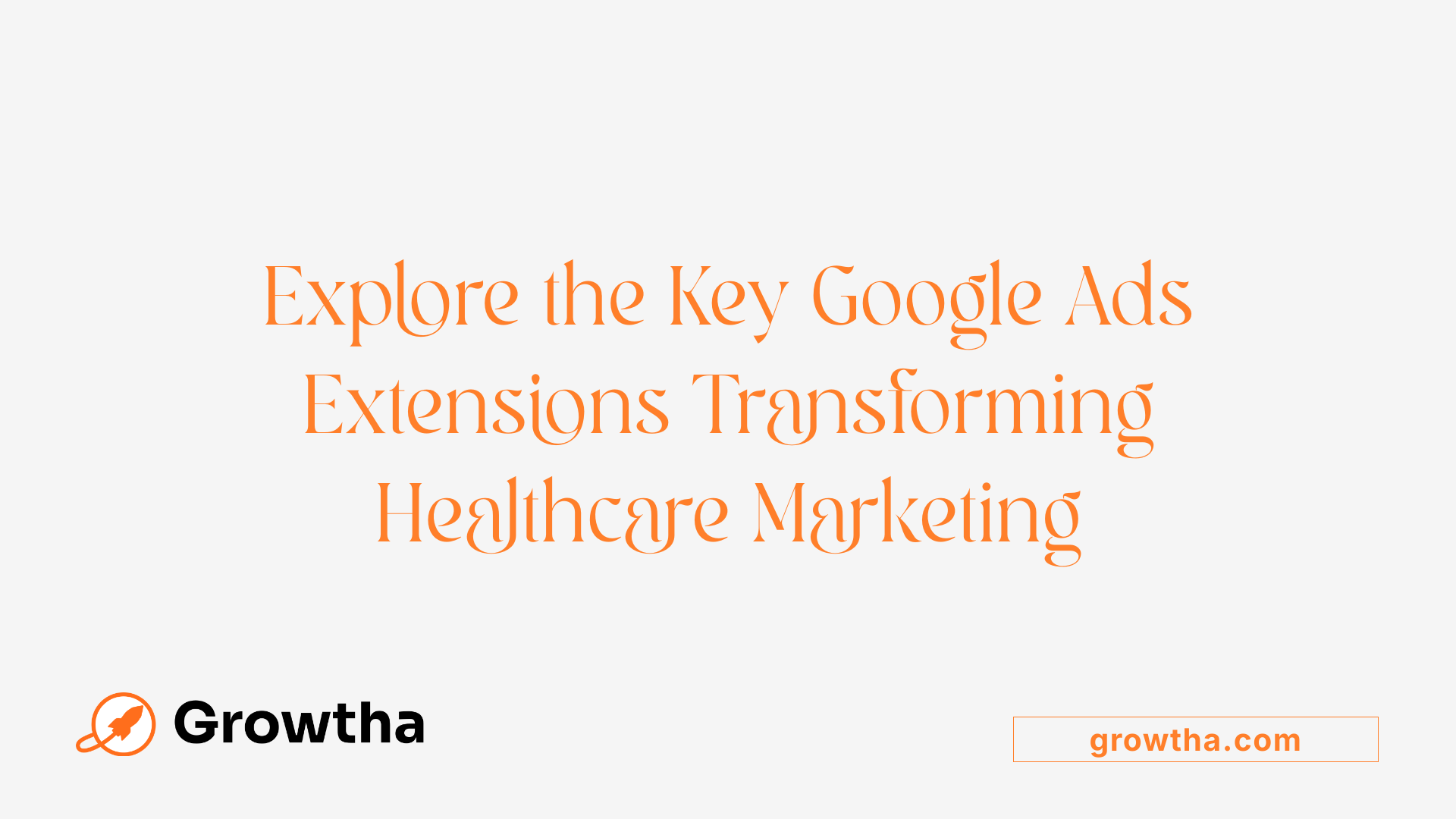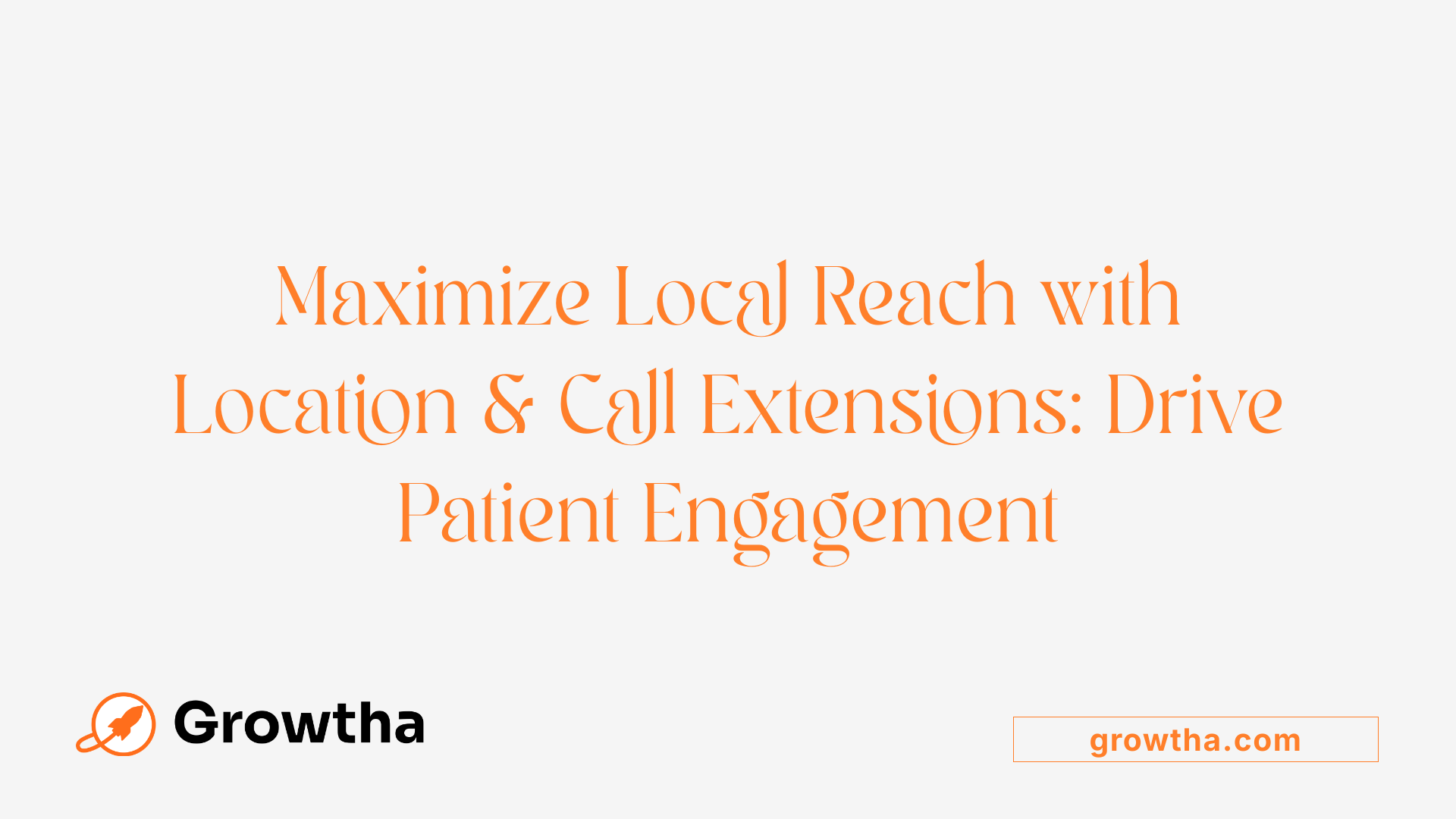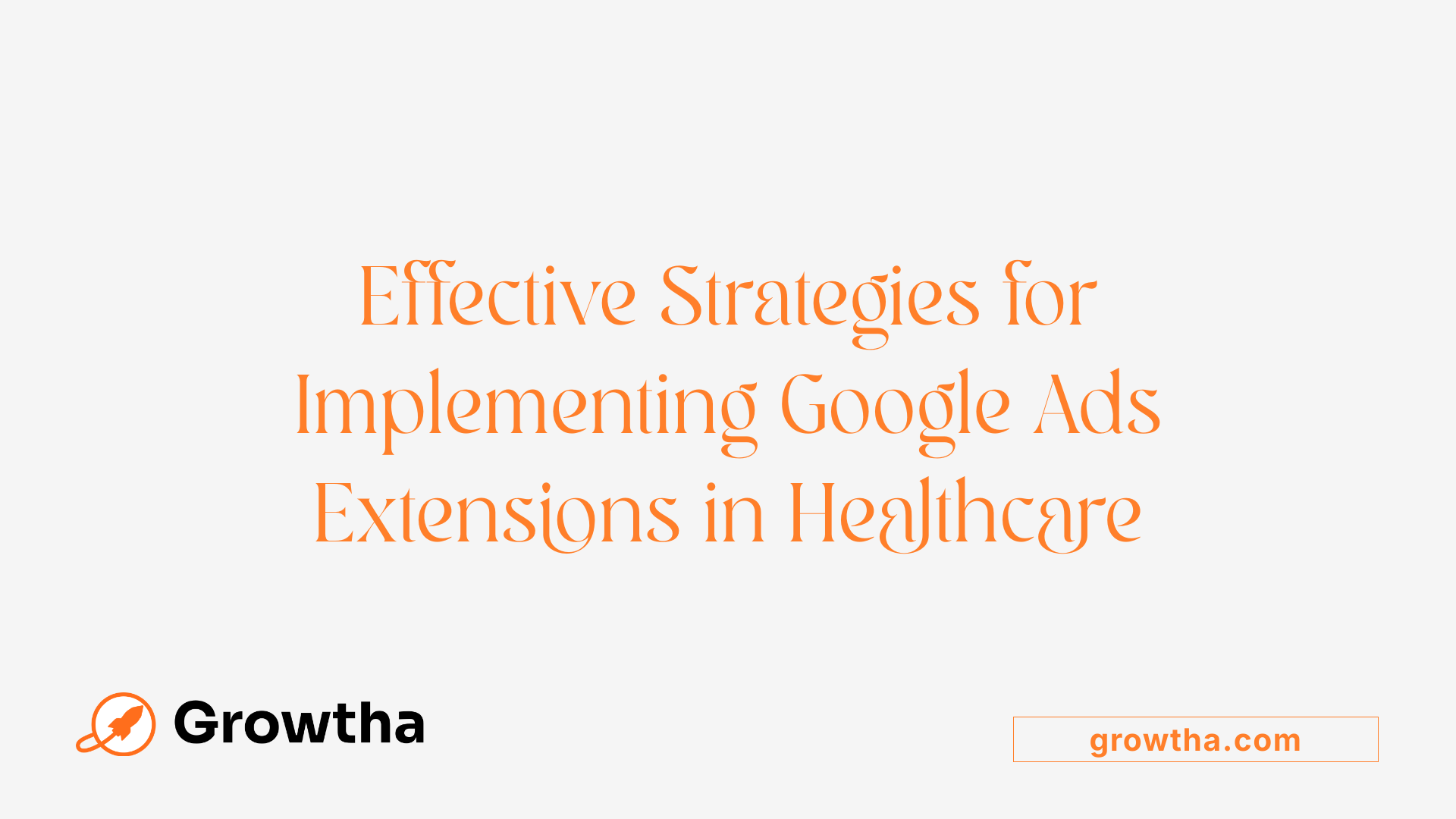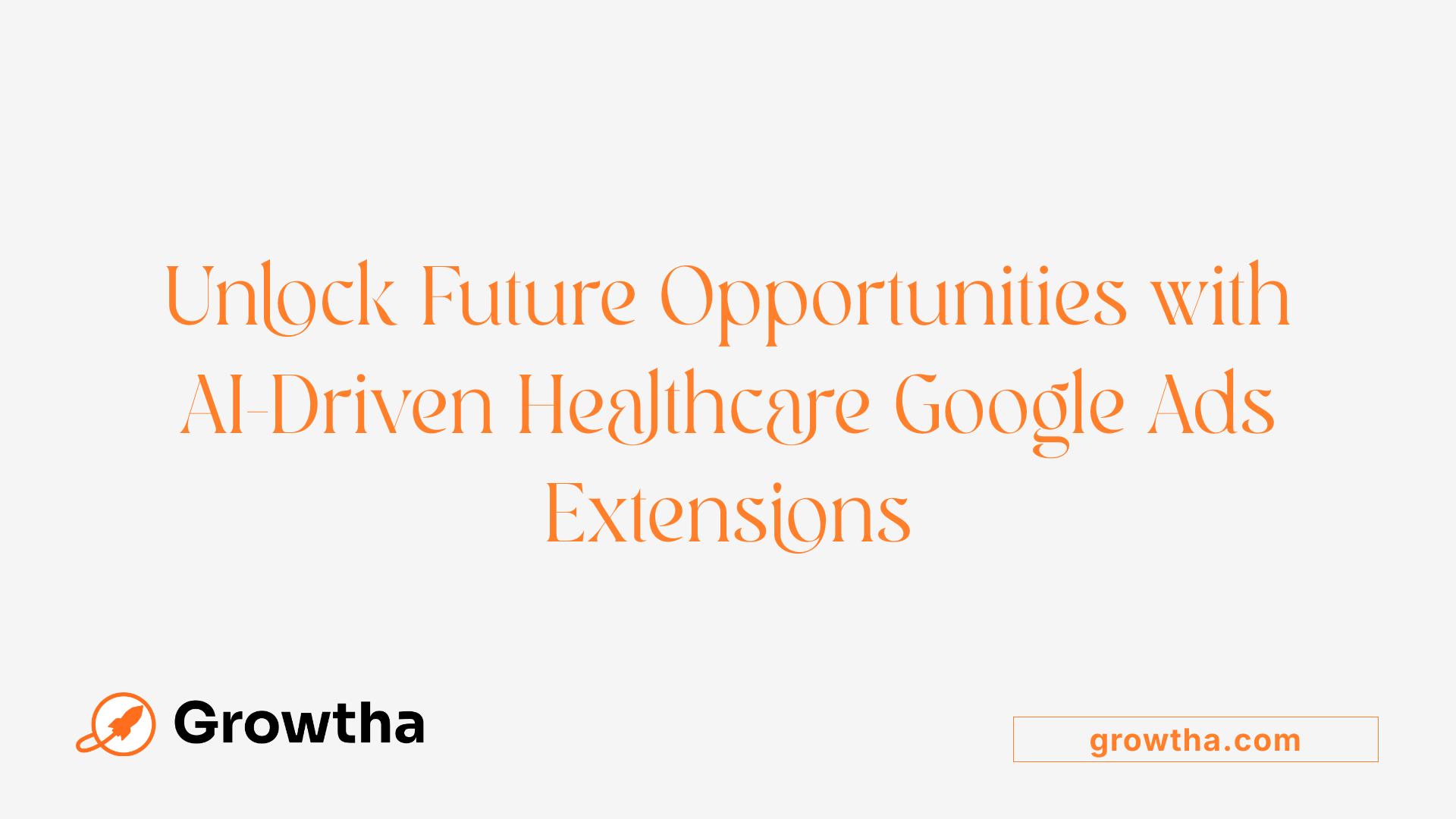How to Use Google Ads Extensions for Medical Services
Maximizing Healthcare Reach with Google Ads Extensions


How to Use Google Ads Extensions for Medical Services
Unlocking the Power of Extensions in Healthcare Advertising
Google Ads extensions are vital tools for healthcare providers aiming to enhance their online visibility, attract more patients, and streamline communication. By strategically implementing various extension types, practices can deliver more relevant, engaging, and accessible search ads. This article offers a comprehensive guide on how healthcare providers can effectively utilize Google Ads extensions to promote their services, improve local visibility, and achieve their marketing goals.
Understanding the Types of Google Ads Extensions in Healthcare
 Google Ads extensions serve as powerful tools for healthcare providers aiming to increase their online visibility and attract more patients through targeted advertising. These extensions add extra layers of information to your ads, making them more relevant and engaging. They can include sitelinks, callout extensions, location details, call buttons, price listings, promotional deals, and lead form options.
Google Ads extensions serve as powerful tools for healthcare providers aiming to increase their online visibility and attract more patients through targeted advertising. These extensions add extra layers of information to your ads, making them more relevant and engaging. They can include sitelinks, callout extensions, location details, call buttons, price listings, promotional deals, and lead form options.
Sitelinks
Sitelink extensions allow healthcare providers to highlight specific services or pages within their website. For example, a clinic can feature sitelinks for 'Blood Tests', 'COVID-19 Testing', or 'Doctor Consultations'. These links help guide users directly to the most relevant sections, increasing the likelihood of appointment bookings or inquiries.
Callout Extensions
Callout extensions are short, clickable snippets that emphasize unique selling points such as 'Same-Day Appointments', 'Board-Certified Doctors', or 'Insurance Accepted'. They add context to your ad, making it more appealing and informative.
Location Extensions
Location extensions display your practice’s address, phone number, and map marker directly in your ad. This encourages nearby patients to find and visit your clinic easily. When combined with Google Maps, they provide seamless directions to your facility.
Call Extensions
Call extensions insert a phone number into your ad, enabling users to call your practice directly with a single tap or click. This feature is crucial for mobile users seeking immediate assistance or appointment scheduling.
Price Extensions
Price extensions showcase the costs of specific services, helping manage patient expectations and attract those seeking transparent pricing. For example, listing 'Blood Test: $50' in your ad can prequalify leads and improve ad relevance.
Promotion Extensions
Promotion extensions highlight special offers or seasonal discounts, enticing potential patients to act quickly. For healthcare clinics, this might include discounts on health screenings or wellness packages.
Lead Form Extensions
Lead form extensions gather contact information directly within your ad, making it easier for patients to request appointments or more details without visiting your website. These are especially useful for capturing high-intent users.
Features and Benefits of Google Ads Extensions for Healthcare
Extensions provide several advantages. They enhance the visibility of your ads, delivering immediate access to vital information. This increased prominence can lead to higher click-through rates and more qualified leads. For healthcare providers, creating a seamless experience — from searching to booking — is essential.
Effective Usage Strategies
To maximize the benefits, healthcare providers should strategically use multiple extensions simultaneously. For instance, combining sitelinks with call and location extensions can direct users to specific services, facilitate quick calls, and help them easily find your practice's physical location.
It's also vital to constantly monitor the performance of these extensions via Google Ads metrics like CTR and conversions. Refining extension content, aligning them with relevant keywords, and ensuring compliance with healthcare advertising policies will support ongoing success.
Setting Up and Optimizing Extensions
Start by signing into your Google Ads account and navigating to the 'Ads & Extensions' tab. Here, you can add new sitelinks, callouts, location, and other extensions tailored to your medical practice. Regularly reviewing performance data allows you to optimize each extension, pausing underperformers and testing new messaging.
Ensuring all extensions adhere to healthcare regulations, including avoiding false health claims or restricted terms, is paramount. With proper setup and ongoing optimization, Google Ads extensions can significantly boost your practice's online reach and patient engagement.
Leveraging Location and Call Extensions for Local Impact

How can healthcare providers leverage Google Ads extensions to enhance local visibility and patient engagement?
In the competitive healthcare market, especially at the local level, visibility is crucial. Healthcare providers can significantly improve their local presence and patient engagement by effectively using Google Ads extensions.
Location extensions are one of the most important tools in this regard. They display your practice’s address, phone number, and a map directly within your ad. This makes it easier for nearby patients to find your clinic or lab quickly. When a potential patient searches for terms like “blood test near me,” location extensions increase the likelihood that your practice appears at the top of search results, complete with essential contact information.
Call extensions further streamline the patient journey by adding a direct call button to your ad. This feature encourages immediate contact, allowing users to call your practice with a simple tap on their mobile devices. For urgent or same-day appointments, this can dramatically boost conversion rates. Moreover, sitelink extensions can direct users to specific service pages or booking forms, making the path from inquiry to appointment seamless.
Together, these extensions not only enhance ad relevance but also improve local SEO by signaling to Google that your practice is a relevant and accessible choice for nearby patients. By making it easy for potential patients to contact or visit your location, you heighten the chances of scheduling appointments and building trust within your community.
What are best practices for implementing Google Ads extensions in healthcare advertising?
To maximize the benefits of ad extensions in healthcare advertising, several best practices should be followed. First, always incorporate geographic targeting to ensure your ads reach the intended local audience. Use location extensions to display your practice's address prominently within your ads. This not only enhances visibility but also helps improve your local search rankings.
Including call extensions is equally vital. Make sure your phone number is accurate, consistent across all platforms, and that the call button is enabled. For healthcare providers promoting specific services, like COVID-19 testing or specialty consultations, using sitelinks to direct users to dedicated landing pages can significantly increase conversions.
Regularly reviewing extension performance data provides insights into user engagement. For example, if the call extension click-through rate is low, verify your contact information and consider adding a tracking number to measure call conversions accurately.
Additionally, extensions should align with your audience’s needs. For instance, promoting telehealth options or highlighting urgent care services can address specific patient concerns effectively. Ensuring your extensions are always current, especially regarding office hours or available services, is essential to maintain trust and credibility.
Finally, ensure compliance with healthcare advertising policies and legal standards, including HIPAA, by avoiding sharing sensitive patient information through extensions. Properly implemented, these strategic practices enhance local visibility, foster patient trust, and drive meaningful engagement.
Best Practices for Extension Strategies in Healthcare Campaigns

What are best practices for implementing Google Ads extensions in healthcare advertising?
Leveraging Google Ads extensions effectively is vital for healthcare providers aiming to boost ad visibility and user engagement. The first step is to incorporate relevant extensions such as call, sitelinks, and location extensions. Call extensions enable potential patients to contact your practice immediately, greatly reducing barriers to appointment booking. Sit links help direct users to specific service pages, like COVID-19 testing or specialized labs, improving user experience and conversion rates.
Geo-targeting is essential; by focusing on local areas, you ensure your ad reach audiences who can physically access your services. Always adhere to healthcare advertising policies, making sure your extensions follow regulations and do not include restricted claims. Constantly monitoring key metrics—such as Click-Through Rate (CTR), conversions, and cost-per-click (CPC)—allows you to assess performance.
Refining extension content based on data insights from campaigns can significantly enhance effectiveness. For instance, updating sitelinks to highlight new or popular services or adjusting location targeting based on performance data can help maximize ROI. Regularly testing different extension formats and messaging ensures your strategy evolves with industry standards and audience needs.
What features and benefits do Google Ads extensions offer to healthcare providers?
Healthcare providers gain numerous advantages from using ad extensions. Increased visibility is one of the primary benefits, as extensions like call buttons and location maps make your ads stand out on search results page. These features facilitate immediate contact—patients can call or locate your facility with a single click—streamlining the pathway from search to appointment.
Localized information through location extensions helps attract nearby patients, especially when combined with geo-targeted ads. Sitelinks allow you to highlight specific services like urgent care, lab testing, or telehealth consultations, adding relevance to your ads.
Beyond visibility and engagement, extensions support compliance with healthcare standards by presenting clear, accurate information—such as office hours and credentials. They also provide a competitive advantage by offering comprehensive, easily accessible information, which can lead to increased patient acquisition. Ultimately, integrating well-structured extensions into your campaign improves overall performance, reduces cost per lead, and enhances patient trust.
How can healthcare providers optimize their extension usage for better results?
Optimizing extensions involves selecting the most relevant types for your service offerings and target audience. Regular analysis of campaign metrics is essential; identify which extensions attract the most clicks or conversions and scale those strategies.
Customizing extension content to reflect current promotions, new services, or important updates keeps your ads fresh and compelling. For example, updating sitelinks to feature seasonal health checkups or new testing options can attract targeted inquiries.
Using location extensions with accurate, up-to-date practice addresses and incorporating call extensions with tracking capabilities help measure direct patient interactions. Consistent testing of different messaging and extension formats ensures continuous improvement.
Finally, ensure your landing pages are aligned with ad extensions—mobile-friendly, quick-loading, and with clear calls to action—to maximize conversion potential. When extensions are employed thoughtfully and data-driven, healthcare providers can substantially enhance their ad campaign effectiveness.
| Aspect | Best Practices | Additional Details |
|---|---|---|
| Regulatory Compliance | Follow healthcare advertising policies, avoid unapproved claims | HIPAA, FDA, and local law adherence required |
| Keyword Integration | Use local, service-specific, and long-tail keywords | E.g., 'blood test lab near me', 'urgent care with blood work' |
| Ad Copy Relevance | Highlight trust & credentials, create urgency | Use terms like 'Same-Day Results', 'Board Certified' |
| Landing Page Optimization | Mobile-friendly, fast load times, clear CTAs | Include convenient appointment links, service details |
| Performance Tracking | Use analytics, convert tracking, and A/B testing | Regularly analyze CTR, conversions, and adjust accordingly |
Employing these best practices in extension strategies helps healthcare campaigns reach the right audience effectively, ensuring compliance, and optimizing ROI.
Feature Highlights and Strategic Benefits of Google Ads Extensions
What features and benefits do Google Ads extensions offer to healthcare providers?
Google Ads extensions are powerful tools that enhance the visibility and effectiveness of healthcare advertising campaigns. They allow providers to display additional information directly within their ads, such as trust and credibility signals, specific services, and location details. These extensions make ads more prominent on search results pages, capturing user attention and encouraging clicks.
By incorporating trust signals like credentials (e.g., CLIA, CAP, FDA), healthcare providers can build confidence with potential patients. Location extensions show the physical practice address, helping nearby patients easily find and visit the facility. Call extensions enable direct communication, facilitating quick inquiries or appointment bookings. Service extensions highlight specific treatments or specialties, attracting targeted audiences seeking particular services.
Overall, these features expand outreach, improve ad relevance, and create more engagement opportunities, leading to increased conversions and patient inquiries.
How can healthcare providers effectively use Google Ads extensions to promote their services?
To maximize the benefits of Google Ads extensions, healthcare providers should strategically incorporate various types of extensions based on their campaign goals.
- Sitelink Extensions: Use these to direct users to specific service pages, such as COVID-19 testing, blood tests, or vaccination clinics. This helps guide potential patients to relevant information quickly.
- Call Extensions: Add a clickable phone number to encourage immediate contact, crucial for urgent care or consultation services. Ensure call tracking is set up to measure the effectiveness of calls from ads.
- Location Extensions: Display practice addresses, maps, and distance information, especially effective for local search queries like “blood test lab near me” or “urgent care near me.”
- Highlight Extensions: Emphasize unique selling points like “Same-Day Service,” “Accredited Lab Facilities,” or “Affordable Testing Options,” to differentiate your practice.
Tailoring message content within extensions to stress trustworthiness, immediacy, or specialization enhances user engagement. Regular monitoring and testing of extension performance can reveal the most effective combinations, optimizing campaign ROI.
Additional insights on healthcare promotion via Google Ads extensions
Creating targeted, compliance-aware campaigns is essential. Ensure ad copy and extensions adhere to healthcare advertising policies and legal regulations like HIPAA. Use precise keyword targeting with local modifiers and service specifics to reach high-intent audiences.
Tracking user interactions through conversions and call monitoring provides insights into campaign success. Combining extensions with well-designed landing pages that are mobile-friendly and clear in their calls-to-action further boosts lead generation.
In summary, Google Ads extensions are vital assets for healthcare providers seeking to improve ad prominence, credibility, and patient engagement. When used thoughtfully, they increase visibility, foster trust, and contribute significantly to practice growth and patient acquisition.
Optimizing Campaigns with Extension Data and Compliance
How do I set up and optimize Google Ads extensions for medical practices?
Implementing Google Ads extensions is a vital step in enhancing your healthcare marketing campaigns. Start by navigating to the 'Ads & Extensions' menu within your Google Ads account. Here, you can add various extension types such as location, call, sitelinks, and callout extensions that are particularly effective for healthcare providers.
Once extensions are added, monitoring their performance through key metrics like click-through rates (CTR), conversion rates, and engagement levels allows you to understand what resonates with your audience. For example, high engagement with call extensions indicates strong interest in direct contact, prompting more focus on these extensions.
Adjustments should be based on data insights. If sitelinks directing users to specific services like COVID-19 testing see higher conversion rates, prioritize these in your campaigns. Conversely, if some extensions underperform, consider replacing or refining their content.
Crucially, ensuring compliance with healthcare-specific regulations and privacy laws, such as HIPAA, is non-negotiable. Avoid sharing protected health information or any claims that could breach legal standards. Optimize landing pages to support your ad copy, making sure they are clear, trustworthy, and compliant.
Finally, continuously test different extensions and messaging strategies through A/B testing. This helps identify the most effective combination that maximizes conversions while adhering to legal standards.
What features and benefits do Google Ads extensions offer to healthcare providers?
Extensions significantly bolster your healthcare advertising efforts by increasing ad visibility and providing immediate options for user engagement. Location extensions display your practice’s address directly in the ad, guiding nearby patients easily. Call extensions enable users to call your practice with a single click, facilitating quick appointments or inquiries.
Sitelink extensions allow you to highlight specific services or health conditions, directing users to dedicated landing pages for more detailed information. Callout extensions are useful for emphasizing unique selling points, like 'Same-Day Appointments' or 'Board-Certified Staff'.
Structured snippets can detail treatment types or specialties, helping set accurate expectations. These features not only improve ad relevance but also foster trust by showing professional credentials such as CLIA, CAP, or FDA approvals.
Altogether, ad extensions increase the likelihood of higher engagement and conversion rates by making your ads more informative and accessible. They support your ROI by driving more qualified traffic to your site and enabling users to take immediate action.
Analyzing Data and Ensuring Healthcare Compliance
A vital aspect of performance optimization involves analyzing analytics and metrics regularly. Google Ads provides insights into CTR, cost per click (CPC), conversion rates, and bounce rates. These data points guide where to refine your campaigns, whether by adjusting bids, targeting, or ad copy.
A/B testing different extension configurations and messaging strategies is essential. For example, testing different call-to-action phrases or extension types can uncover what best motivates patient engagement.
Healthcare regulations impose strict boundaries to protect patient privacy and prevent misleading claims. Always review your ad copy, extensions, and landing pages to ensure adherence to policies. Use clear, truthful language and avoid sensitive health information that could violate HIPAA.
Implement privacy considerations diligently. Use secure landing pages, avoid sharing protected health details, and be transparent about how user data is handled. Employ strong data security practices, especially when tracking conversions or integrating with patient management systems.
Additional Tips for Success
- Leverage location targeting to focus your extensions on local audiences.
- Use negative keywords to filter irrelevant traffic.
- Set up conversion tracking for calls, appointment bookings, or contact form submissions.
- Regularly update ad copies and extensions to reflect new services, offers, or compliance standards.
- Integrate campaign management with broader marketing efforts for better consistency.
Through diligent setup, continuous monitoring, A/B testing, and strict adherence to healthcare policies, your Google Ads campaigns can effectively attract and engage patients, maximizing both impact and compliance.
Performance Metrics and Continuous Improvement
Tracking engagement with ad extensions involves key metrics like extension click-through rate, conversion rate from extension clicks, and overall ad performance. Use Google Analytics and Google Ads integration to gain comprehensive insights.
Focus on high-performing extensions and refine or eliminate underperforming ones. Set specific objectives, such as increasing appointment bookings or telehealth consultations, and measure these goals explicitly.
By combining advanced analytics, strategic testing, and stringent compliance measures, healthcare providers can optimize their Google Ads extensions to ensure sustained growth and patient trust.
| Aspect | Focus Area | Recommended Practice |
|---|---|---|
| Setup | Extension Implementation | Use 'Ads & Extensions' menu to add and customize extensions |
| Performance Monitoring | Analytics & Metrics | Track CTR, conversions, and engagement regularly |
| Testing | A/B Testing | Compare different extension types and messaging |
| Compliance | Healthcare Regulations | Follow HIPAA, FDA, and other legal standards |
| Privacy | Data Handling | Ensure secure landing pages and transparent data policies |
| Optimization | Campaign Refinement | Adjust bids, language, and extensions based on data |
By applying these strategies and principles, healthcare advertising campaigns on Google Ads can perform efficiently, ethically, and effectively, ultimately leading to increased patient engagement and practice growth.
Integration of Extensions with Broader Healthcare Marketing Strategies
How do ad extensions enhance multi-channel marketing efforts?
Ad extensions are a vital component of a comprehensive healthcare marketing strategy because they extend the impact of Google Ads beyond simple text links. These extensions, including location, call, and site links, work synergistically with other channels such as social media, email campaigns, and offline efforts to create a cohesive brand experience. By providing additional contact details and quick access to specific services directly within the ad, healthcare providers can guide potential patients seamlessly through the buyer’s journey.
For example, when combined with social media campaigns, ad extensions can reinforce messaging and improve visibility. When used with email marketing, they enable direct calls or appointment scheduling links, creating multiple touchpoints for engaging patients.
What role do extensions play in hospital and clinic branding?
Extensions like sitelinks and callout snippets serve not just functional purposes but also reinforce the hospital or clinic’s brand identity. Showcasing credentials such as certifications (e.g., CLIA, CAP, FDA), highlighting specialties, or emphasizing unique offerings (same-day testing, 24/7 availability) establishes authority and trust.
Implementing these extensions consistently across campaigns helps patients recognize brand consistency, which is crucial for reputation building. Furthermore, enhanced ad visibility and prominence foster familiarity, encouraging clicks and visits.
How can offline and online marketing be integrated?
Successful healthcare marketing balances online visibility with offline branding efforts. Ad extensions support this integration by bridging digital ads with real-world touchpoints. For instance, location extensions can direct users to visit a physical facility, while call extensions can prompt immediate phone inquiries, connecting digital interest with offline engagement.
Healthcare providers can complement Google Ads with offline efforts like community seminars, health fairs, or direct mail. These offline activities can point audiences to online campaigns or encourage visits to the practice, creating a cycle of engagement.
What is the importance of industry partnerships?
Industry collaborations amplify the reach and credibility of healthcare campaigns. Partnering with local health organizations, specialists, or pharmaceutical providers can offer co-branded ad extensions, like joint health initiatives or sponsored content, appearing in multi-channel advertising efforts.
Google Ads extensions can feature these partnerships, such as highlighting joint offerings or accreditation status, elevating trustworthiness. These collaborations foster community engagement and expand the practice’s visibility to in-market audiences actively seeking healthcare services.
How to align ad extensions within a comprehensive healthcare marketing plan?
Integrating ad extensions into a broader healthcare marketing strategy requires careful planning. The foundation is clear objectives—whether increasing patient volume, promoting specialized services, or boosting brand recognition.
Coordinate extensions to support campaign themes. For instance, a campaign focused on urgent care should prominently feature location and call extensions, while preventative care campaigns might leverage sitelinks leading to educational resources.
Moreover, consistently monitor and optimize the use of extensions, ensuring they align with evolving healthcare trends and patient needs. Make use of data from analytics tools like Google Analytics and Google Search Console to fine-tune extensions for maximum engagement and ROI.
Final notes on integrating Google Ads extensions and healthcare marketing
A well-structured, multi-channel healthcare marketing effort recognizes the significance of ad extensions in delivering tailored, accessible, and authoritative information. By leveraging these tools alongside offline activities, industry partnerships, and branding strategies, healthcare providers can build a strong, trusted presence that drives patient engagement, enhances reputation, and grows their practice effectively.
Content tailored to specific campaigns — emphasizing credentials, local focus, and service quality — combined with intelligent extension use, fosters a comprehensive approach that meets patient expectations and industry standards.
For further insights, explore the search query: integrating Google Ads with healthcare marketing. This ongoing process ensures that healthcare practices remain competitive and relevant in a rapidly evolving digital landscape.
Future Trends and Opportunities with Healthcare Google Ads Extensions

How is AI-driven automation shaping healthcare Google Ads extensions?
Artificial Intelligence (AI) is transforming how healthcare providers utilize Google Ads extensions. AI-driven automation allows for smarter, real-time adjustments to ad campaigns based on user behavior, location, and engagement patterns. Automated bidding strategies can optimize budget allocation, while machine learning algorithms can suggest the most effective extensions for specific audiences.
For example, AI can automatically enable or disable call extensions depending on the time of day or display location extensions when users are nearby. This dynamic approach ensures that ads are always relevant and effective, reducing waste and maximizing ROI.
How can healthcare providers leverage personalized patient engagement?
Personalized engagement is increasingly vital in healthcare marketing. With Google Ads extensions, providers can tailor messaging based on patient needs or interests. For instance, using sitelink extensions to promote specific services like flu shots or COVID-19 testing encourages targeted interactions.
Dynamic ad copy can also be generated using audience data, highlighting the benefits most relevant to each visitor—such as quick appointment scheduling or trusted credentials like CLIA or FDA approvals. Personalized calls to action, combined with extensions like 'Book Now' or 'Contact Us', improve patient responsiveness and trust.
What do recent regulatory updates mean for healthcare advertising on Google?
Healthcare advertising is heavily regulated to protect patient privacy and ensure truthful advertising. Recent updates from authorities include stricter guidelines around health claims, patient data privacy, and HIPAA compliance.
Google continually updates its ad policies to align with these legal requirements, requiring healthcare providers to be vigilant. Advertisers must ensure that no sensitive health information is disclosed and that claims are backed by approved credentials.
This means that healthcare providers should stay informed about policy changes, incorporate compliant messaging, and utilize features like restricted keyword targeting and review mechanisms to avoid violations. Failing to comply can result in ad disapproval or account suspension.
What growth opportunities do emerging trends present?
The evolving landscape of healthcare Google Ads extensions offers numerous growth avenues. Niche keywords targeting specific conditions or services—like 'home blood testing' or 'urgent blood work near me'—can capture highly relevant traffic.
Moreover, integrating AI-powered audience segmentation allows providers to reach in-market users more precisely. Combining traditional search campaigns with display, video, and remarketing strategies broadens reach and maintains engagement over the patient journey.
Utilizing advanced extensions like structured snippets to highlight a variety of services or certifications can improve ad relevance and credibility. Partnerships with local organizations and continuous competitor analysis further identify gaps and opportunities.
How is the future of healthcare Google Ads extensions expected to unfold?
The future points toward even more intelligent, personalized, and compliant advertising solutions. AI will enable hyper-targeted, real-time adjustments based on patient behavior and health trends.
Healthcare providers are likely to adopt more interactive extensions—such as appointment scheduling directly within Google search results or integrated chatbots for preliminary consultations.
Privacy-preserving technologies will ensure smarter targeting that respects patient confidentiality while still delivering impactful ads.
Overall, healthcare Google Ads extensions will become more sophisticated, seamlessly integrated into patient decision-making processes, and tailored to meet both marketing objectives and regulatory standards.
| Aspect | Current State | Future Outlook | Impact for Healthcare Providers |
|---|---|---|---|
| AI Automation | Partial automation for bidding and targeting | Fully autonomous, real-time campaign adjustments | Increase in efficiency and precision |
| Personalization | Segment-based messaging | Hyper-personalized, dynamic content | Enhanced patient engagement and trust |
| Regulatory Compliance | Strict policies for claims and data | Advanced tools for compliance management | Reduced risk of violations and penalties |
| Growth Opportunities | Niche keywords and extensions | Integrative, multi-channel campaigns | Expanded reach and increased leads |
| Innovation in Extensions | Standard sitelinks and callouts | Interactive, AI-driven extensions | Improved click-through rates and conversions |
As healthcare digital marketing continues to progress, adopting these trends will be crucial for practices seeking competitive advantage in patient acquisition and retention.
Harnessing the Full Potential of Google Ads Extensions in Healthcare
Effective utilization of Google Ads extensions is essential for healthcare providers looking to increase online visibility, engage patients efficiently, and comply with legal standards. By strategically selecting, implementing, and optimizing extensions that showcase their services, location, and credibility, practices can transform their digital marketing efforts. Continuous monitoring, adherence to healthcare policies, and leveraging data-driven insights will ensure these tools maximize ROI and foster sustained growth in the competitive medical landscape. Harnessing the power of Google Ads extensions positions healthcare practices not just for immediate patient growth but for long-term success in digital health marketing.
References
- How to Maximize Google Ads for Doctors - iMatrix
- Google Ads for Medical Lab and Testing: A Comprehensive Setup ...
- Enhance Your Business With Google Ads - Doctor Multimedia
- How to Set Up Google Ads for Healthcare Businesses in 2025 - CMG
- Medical Marketing: A Complete Guide to Google PPC - Cactus Mailing
- Medical Advertising Using Google PPC Ads (For Doctors and Dentists)
- Maximize Patient Leads with Google Ads for Concierge Doctors
- Google Ads for Doctors: A Comprehensive Setup Guide | Sona
- How To Set Up Google Ads For Medical Services
- How Google Ads Can Help Fill Last-Minute Appointment Slots







